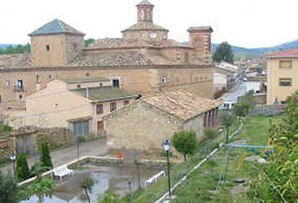Gea de Albarracín
| Municipality of Gea de Albarracín | ||
|---|---|---|
 Gea de Albarracín - town center with Convento del Carmen
|
||
| coat of arms | Map of Spain | |

|
|
|
| Basic data | ||
| Autonomous Community : |
|
|
| Province : | Teruel | |
| Comarca : | Sierra de Albarracín | |
| Coordinates | 40 ° 25 ′ N , 1 ° 21 ′ W | |
| Height : | 1030 msnm | |
| Area : | 57.5 km² | |
| Residents : | 360 (Jan 1, 2019) | |
| Population density : | 6.26 inhabitants / km² | |
| Postal code : | 44110 | |
| Municipality number ( INE ): | 44117 | |
| administration | ||
| Website : | Gea de Albarracín | |
Gea de Albarracín is a place and a municipality ( municipio ) with 360 inhabitants (as of January 1, 2019) in the province of Teruel in the southwest of the autonomous region of Aragon in eastern Spain .
Location and climate
The place Gea de Albarracín is located on the Río Guadalaviar in the southeast of the Iberian Mountains about 24 kilometers (driving distance) northwest of the city of Teruel at an altitude of about 1030 m . The climate is temperate to warm; Rain (approx. 455 mm / year) falls over the year.
Population development
| year | 1857 | 1900 | 1950 | 2000 | 2017 |
| Residents | 1,047 | 1,151 | 981 | 453 | 372 |
The mechanization of agriculture as well as the abandonment of small farms and the resulting loss of jobs led to a significant population decline ( rural exodus ) in the second half of the 20th century .
economy
For centuries the community lived exclusively from growing grain ( barley and wheat ), which was mainly operated for self-sufficiency ; livestock farming (sheep, goats, chickens) also took place to a small extent. The place Torres de Albarracín served as a mercantile, handicraft and cultural center for the hamlets and farmsteads in its area, which have now mostly disappeared. Today agriculture still plays the most important role; There is hardly any income from tourism.
history
In the 1st millennium BC Celtiberian tribal groups of the Lobetans probably settled in the region . The Roman aqueduct (acueducto) from Albarracín to Cella runs through the municipality. Visigothic traces have not yet been discovered. During the period of the gradual collapse of the Caliphate of Cordoba , the Berber dynasty of the Banu Racin founded a short-lived Taifa emirate . In the early 13th century the place became Christian.
Attractions
- The parish church of San Bernardo is an unadorned Baroque building from the 17th century. The interior has three aisles; the central nave has a stitch cap vault . The apse is broken polygonally; the altarpiece (retablo) dates from 1750.
- The Convento del Carmen belonged to the Carmelite Order and dates from the 2nd half of the 17th century. The cloister (claustro) has three floors and is one of the most beautiful of its kind.
- The Convento de Capuchinas belonged to the female branch of the Capuchin Order and dates from the mid-18th century.
- Two hermit churches (ermitas) are on the outskirts.
Web links
Individual evidence
- ↑ Cifras oficiales de población resultantes de la revisión del Padrón municipal a 1 de enero . Population statistics from the Instituto Nacional de Estadística (population update).
- ↑ Gea de Albarracín - climate tables
- ^ Gea de Albarracín - population development
- ↑ Gea de Albarracín - Church of San Bernardo
- ↑ Gea de Albarracín - Church of San Bernardo
- ^ Gea de Albarracín - Convento del Carmen
- ↑ Gea de Albarracín - Convento de Capuchinas

